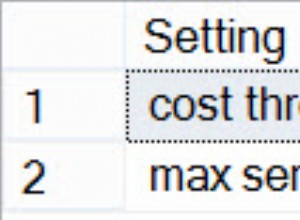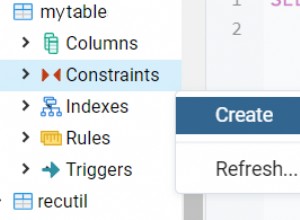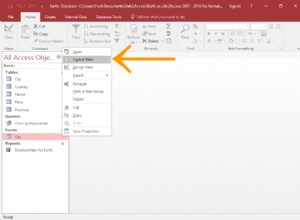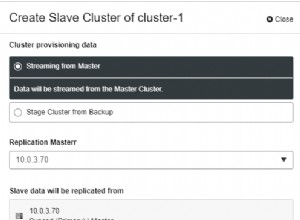Ci sono diversi modi in cui questo può essere fatto. Elencherò due modi. Ognuno ha vantaggi e svantaggi. Personalmente userei il primo (SQL dinamico).
- Vantaggi:veloce, non richiede ricorsione
- Svantaggi:non può essere utilizzato per aggiornare le variabili della tabella
- Vantaggi:consente l'aggiornamento delle variabili della tabella
- Svantaggi:richiede la ricorsione ed è ad alta intensità di memoria, i CTE ricorsivi sono lenti
1.A. SQL dinamico:tabelle regolari e tabelle temporanee.
Questo esempio utilizza una tabella temporanea come origine del testo:
CREATE TABLE #tt_text(templatebody VARCHAR(MAX));
INSERT INTO #tt_text(templatebody)VALUES
('This is to inform #first_name# about the issues regarding #location#');
CREATE TABLE #tt_repl(variable VARCHAR(256),template_value VARCHAR(8000));
INSERT INTO #tt_repl(variable,template_value)VALUES
('#first_name#','Joseph William'),
('#location#','Alaska');
DECLARE @rep_call NVARCHAR(MAX)='templatebody';
SELECT
@rep_call='REPLACE('[email protected]_call+','''+REPLACE(variable,'''','''''')+''','''+REPLACE(template_value,'''','''''')+''')'
FROM
#tt_repl;
DECLARE @stmt NVARCHAR(MAX)='SELECT '[email protected]_call+' FROM #tt_text';
EXEC sp_executesql @stmt;
/* Use these statements if you want to UPDATE the source rather than SELECT from it
DECLARE @stmt NVARCHAR(MAX)='UPDATE #tt_text SET templatebody='[email protected]_call;
EXEC sp_executesql @stmt;
SELECT * FROM #tt_text;*/
DROP TABLE #tt_repl;
DROP TABLE #tt_text;
1.B. SQL dinamico:variabili di tabella.
Richiede che la tabella sia definita come un tipo di tabella specifico. Esempio di definizione del tipo:
CREATE TYPE dbo.TEXT_TABLE AS TABLE(
id INT IDENTITY(1,1) PRIMARY KEY,
templatebody VARCHAR(MAX)
);
GO
Definire una variabile di tabella di questo tipo e utilizzarla in un'istruzione SQL dinamica come segue. Tieni presente che non è possibile aggiornare una variabile di tabella in questo modo.
DECLARE @tt_text dbo.TEXT_TABLE;
INSERT INTO @tt_text(templatebody)VALUES
('This is to inform #first_name# about the issues regarding #location#');
DECLARE @tt_repl TABLE(id INT IDENTITY(1,1),variable VARCHAR(256),template_value VARCHAR(8000));
INSERT INTO @tt_repl(variable,template_value)VALUES
('#first_name#','Joseph William'),
('#location#','Alaska');
DECLARE @rep_call NVARCHAR(MAX)='templatebody';
SELECT
@rep_call='REPLACE('[email protected]_call+','''+REPLACE(variable,'''','''''')+''','''+REPLACE(template_value,'''','''''')+''')'
FROM
@tt_repl;
DECLARE @stmt NVARCHAR(MAX)='SELECT '[email protected]_call+' FROM @tt_text';
EXEC sp_executesql @stmt,N'@tt_text TEXT_TABLE READONLY',@tt_text;
L'unico motivo per cui dovresti scrivere questo utilizzando un CTE ricorsivo è che intendi aggiornare una variabile di tabella o non ti è consentito utilizzare Dynamic SQL in qualche modo (ad esempio la politica aziendale?).
Nota che il livello di ricorsione massimo predefinito è 100. Se hai più di 100 variabili sostitutive dovresti aumentare questo livello aggiungendo OPTION(MAXRECURSION 32767) alla fine della query (vedi Suggerimenti per le query
- MAXRECURSION ).
DECLARE @tt_text TABLE(id INT IDENTITY(1,1),templatebody VARCHAR(MAX));
INSERT INTO @tt_text(templatebody)VALUES
('This is to inform #first_name# about the issues regarding #location#');
DECLARE @tt_repl TABLE(id INT IDENTITY(1,1),variable VARCHAR(256),template_value VARCHAR(8000));
INSERT INTO @tt_repl(variable,template_value)VALUES
('#first_name#','Joseph William'),
('#location#','Alaska');
;WITH cte AS (
SELECT
t.id,
l=1,
templatebody=REPLACE(t.templatebody,r.variable,r.template_value)
FROM
@tt_text AS t
INNER JOIN @tt_repl AS r ON r.id=1
UNION ALL
SELECT
t.id,
l=l+1,
templatebody=REPLACE(t.templatebody,r.variable,r.template_value)
FROM
cte AS t
INNER JOIN @tt_repl AS r ON r.id=t.l+1
)
UPDATE
@tt_text
SET
templatebody=cte.templatebody
FROM
@tt_text AS t
INNER JOIN cte ON
cte.id=t.id
WHERE
cte.l=(SELECT MAX(id) FROM @tt_repl);
/* -- if instead you wanted to select the replaced strings, comment out
-- the above UPDATE statement, and uncomment this SELECT statement:
SELECT
templatebody
FROM
cte
WHERE
l=(SELECT MAX(id) FROM @tt_repl);*/
SELECT*FROM @tt_text;




